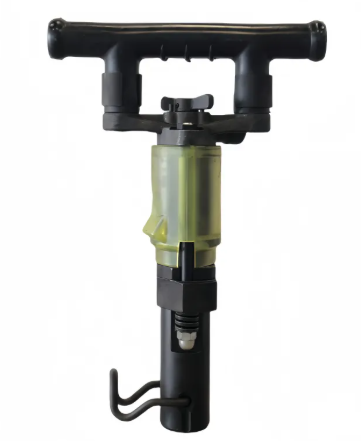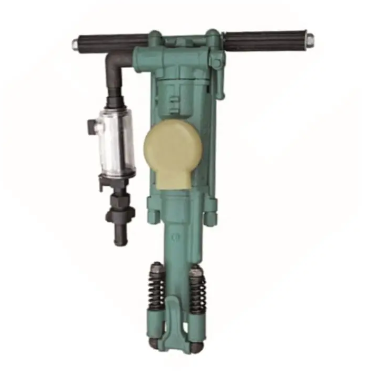Enhancing Mining Operations with Pneumatic Rock Drills
Mining companies are always looking to get better at keeping workers safe while also getting more done with less waste. When mines go deeper into tricky rock layers, the right equipment makes all the difference. Pneumatic rock drills stand out as must-have tools because they pack serious power but still let operators control exactly where the drill goes, which cuts down on accidents. These heavy duty machines changed the game for both deep shafts and open pit mines too. They help miners avoid dangerous situations and make sure holes are drilled precisely where needed, something that was much harder before this technology came along.
Addressing Safety Challenges in Harsh Environments
Mining is inherently hazardous, with workers exposed to falling rocks, confined spaces, and unpredictable geological conditions. Pneumatic rock drills help minimize direct human exposure by allowing remote or semi-automated drilling in otherwise dangerous zones. Compared to traditional manual drilling, these machines reduce vibration-related injuries and exposure to silica dust.
Safety in mining operations gets a big boost from the fact that pneumatic rock drills don't produce electrical sparks, making them a safer choice for areas prone to explosions. When compared to their electric counterparts, these air-powered tools significantly cut down on the chance of igniting methane buildup in those dangerous underground environments. For miners working deep below ground, this difference matters a lot since fire risks need constant monitoring. The absence of sparking means fewer headaches for safety officers trying to keep everyone alive while extracting valuable resources from coal seams and other hazardous locations.
Stable Operation Even in Wet or Dusty Conditions
The mines tend to be pretty harsh places with lots of moisture in the air, tons of dust floating around, and water constantly finding its way into everything. Pneumatic rock drills handle all this stuff just fine, sometimes even better than other tools in similar situations. These machines have parts protected from getting clogged with dirt, and since they run on compressed air instead of electricity, water isn't really a problem for them. For miners working day after day underground, this kind of reliability makes a big difference. When tools keep working properly without breaking down unexpectedly, workers aren't put in dangerous situations where faulty equipment might cause accidents or injuries to others nearby.
Efficiency and Versatility in Rock Drilling
Beyond safety, pneumatic rock drills are valued for their operational efficiency. Designed for both handheld and rig-mounted use, these drills handle various types of rock and can be adapted for vertical, horizontal, or angled drilling.
Precision in Hard Rock Excavation
Mining hard rock requires equipment capable of breaking through tough formations without going overboard. Pneumatic drills come with pressure adjustments so miners can tweak their approach depending on what kind of rock they're dealing with. The ability to control how much force gets applied makes all the difference when trying to keep intact the surrounding material while avoiding those nasty surprises like sudden cave-ins or digging too deep into an area. When done right, this kind of careful drilling actually improves the amount of valuable minerals extracted from each site. Plus it's just plain smarter for safety reasons and saves money in the long run compared to other methods that might cause unnecessary damage.
Lightweight and Easy to Maintain
Pneumatic rock drills remain a staple in mining operations mainly because they're pretty straightforward machines. Compared to hydraulic or electric alternatives, these tools just don't have as many moving parts which means less hassle when it comes time for maintenance work and far fewer chances of something breaking down at an inconvenient moment. Another big plus? Weight matters a lot in this industry too. Pneumatic models tend to be significantly lighter weight than similar machinery on the market today, making them much simpler to move around those rough terrain mining areas where getting heavy equipment from one spot to another can be quite challenging. The ability to quickly relocate becomes absolutely essential for companies working across several different drilling locations or needing to adjust positions regularly based on changing conditions underground.
Environmental and Energy Considerations
The mining industry is increasingly focused on minimizing its environmental footprint. Pneumatic rock drills align with these goals by offering efficient air-powered operation and reduced emissions.
Compressed Air Systems and Energy Optimization
While pneumatic systems require compressors, modern setups are far more energy-efficient than previous generations. Operators can manage airflow dynamically, delivering only as much pressure as needed for a given task. This flexibility not only conserves energy but also limits air and noise pollution in sensitive environments.
In addition, many mining companies now integrate pneumatic drills into centralized compressor networks, which can power multiple tools simultaneously with minimal waste. This integrated approach reduces the total equipment footprint and simplifies energy management across the site.
Minimizing Ground Disturbance
Because pneumatic drills offer controlled, consistent force, they cause less collateral damage to surrounding geological structures. This is especially important in environmentally protected zones or in cases where the stability of adjacent formations is a concern. By limiting vibration and rock fragmentation, these tools support more sustainable extraction practices.

Choosing the Right Pneumatic Drill for Mining Applications
Not all pneumatic rock drills are built the same. Different mining operations require different tool capabilities, so understanding the distinctions can help companies make better investments.
Handheld vs. Rig-Mounted Drills
Handheld pneumatic drills are ideal for small-scale operations or areas with limited access, while rig-mounted models excel in high-volume or high-depth drilling tasks. Rig-mounted systems often allow for multiple drill heads and better stabilization, making them suitable for deep tunneling or long-term projects.
Handheld versions, on the other hand, are valued for their maneuverability and speed in quick excavation jobs or in spaces where setting up rigs is impractical. The choice between the two often depends on the terrain, frequency of use, and depth of drilling required.
Drill Bit Compatibility and Customization
Drill bit compatibility matters too when working with pneumatic tools. These air-powered drills take different kinds of bits based on what kind of rock we're dealing with, how big a hole needs to be made, and even the angle at which it cuts through material. Getting the correct bit for specific jobs makes things work better overall and helps keep the machinery running longer without breakdowns. Most tool companies actually sell replacement parts separately these days, plus they provide ways to modify existing setups as projects change requirements over time. Some folks swear by certain brands because they just fit better in their particular drilling situations.
Maintenance Best Practices for Longevity and Safety
Regular maintenance is crucial for pneumatic rock drills, particularly in harsh mining conditions where dust and moisture are omnipresent.
Routine Inspections and Lubrication
Operators should conduct daily inspections to check for air leaks, worn seals, or bit damage. Proper lubrication of internal parts is essential to prevent corrosion and wear. Most pneumatic drills feature built-in oilers that automatically apply lubricant during operation, but these should be checked frequently to ensure proper function.
Storage and Transport Guidelines
When not in use, drills should be stored in dry environments to avoid internal condensation and rusting. Transporting pneumatic equipment requires securing hoses and fittings to prevent mechanical strain. Using custom cases or protective mounts can further reduce the risk of accidental damage during relocation.
Future Trends in Pneumatic Drilling Technology
The mining industry is seeing a lot of changes as automation and digital monitoring systems get adopted more widely, and this includes pneumatic rock drills too. Many newer drill models actually have built-in sensors these days that track various performance indicators on the fly. These sensors can give warnings when something looks off so problems don't get worse over time. Some manufacturers have gone even further by making their drills compatible with remote control systems. This means workers can run the equipment from safer spots away from the actual drilling site or even from main control rooms at the surface level where conditions are better controlled.
These advancements will likely continue to push the industry toward safer, smarter mining operations, with pneumatic drills remaining a central component due to their inherent safety benefits and adaptability.
FAQ
Why are pneumatic rock drills considered safer than electric drills in mining?
Pneumatic rock drills do not produce sparks, making them safer for use in explosive or flammable environments such as underground coal mines. They also generate less heat and can operate effectively in wet or dusty conditions.
What type of maintenance is required for pneumatic rock drills?
Regular maintenance includes inspecting hoses and fittings, ensuring proper lubrication, checking for air leaks, and storing equipment in dry conditions. Preventive care greatly extends the service life and maintains safe operation.
Are pneumatic rock drills suitable for all types of rock?
Yes, pneumatic drills can be adapted for use with various rock densities by adjusting air pressure and selecting appropriate drill bits. This flexibility makes them suitable for hard rock, soft rock, and layered geological formations.
How do pneumatic rock drills contribute to productivity?
These drills are fast, portable, and reliable. Their consistent performance in harsh environments allows for continuous drilling with minimal downtime, directly improving operational efficiency in mining projects.


